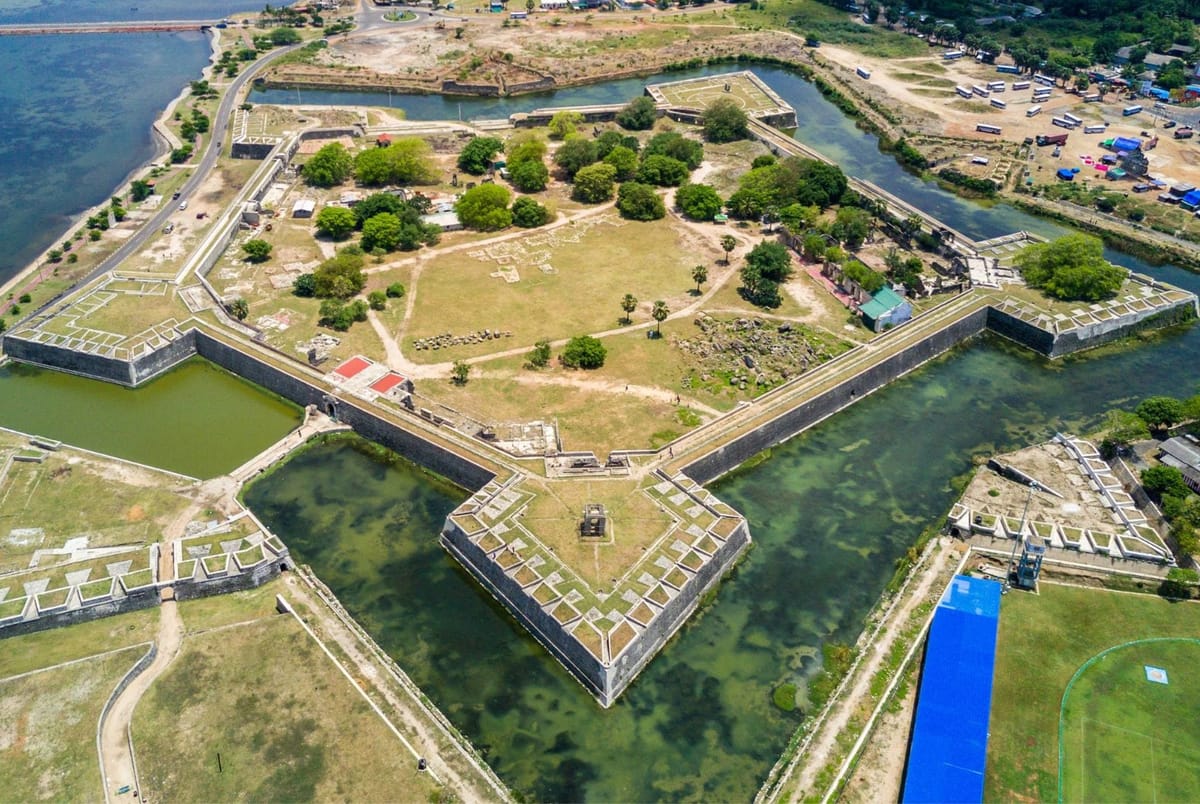Jaffna Fort

Nestled beside the tranquil Jaffna Lagoon, Jaffna Fort stands as a powerful symbol of Sri Lanka’s colonial past, embodying centuries of history, conflict, and resilience. Built by the Portuguese in 1619, this imposing fort has been a silent witness to some of the most significant moments in Sri Lanka’s history, from colonial power struggles to the civil war that ravaged the country. Today, Jaffna Fort beckons visitors to wander through its storied walls, explore its expansive grounds, and soak in panoramic views of the city and lagoon from its towering ramparts.
Colonial History & Changing Hands
Jaffna Fort’s history is as layered as the stones it’s built from. Constructed by the Portuguese after their invasion of the Jaffna Kingdom, the fort served as a strategic military stronghold for nearly 40 years, enduring multiple uprisings and local resistance. In 1658, the Dutch captured the fort, expanding its structure and giving it the distinctive pentagonal design that you can still see today. The Dutch built massive gates, moats, and reinforced bastions, making the fort one of the most formidable on the island.
In 1795, as British forces expanded their influence over Sri Lanka, they took over Jaffna Fort without much resistance. Though its role in battles diminished, the fort continued to play a significant part in the British colonial administration, overseeing local governance and trade. For centuries, Jaffna Fort stood at the crossroads of colonial expansion, making it one of Sri Lanka’s most fascinating and enduring landmarks.
The Civil War & Restoration Efforts
Fast-forward to the 20th century, and Jaffna Fort once again found itself at the center of conflict, this time during Sri Lanka’s civil war. In 1990, after a brutal 107-day siege, the fort was captured by the LTTE, leaving much of it damaged. It became a military outpost, and the scars of war can still be seen in the fort’s structure.
However, following the end of the civil war in 2009, efforts began to restore the fort to its former glory. The Dutch government has supported the restoration of the fort’s coral, stone, and brick walls, emphasizing the need to preserve this architectural gem for future generations. Walking through the fort today, visitors can see ongoing work to rebuild key sections and bring back the fort’s old grandeur.
Exploring Jaffna Fort Today
A visit to Jaffna Fort is like stepping back in time, but also a reminder of how history and modernity intersect in Sri Lanka. The ramparts offer stunning, 360-degree views of Jaffna city and the peaceful lagoon beyond. It’s particularly beautiful at sunset, when the soft golden light bathes the fort in a warm glow. As you stand on these ancient walls, it’s easy to imagine soldiers centuries ago, keeping watch over the surrounding waters.
Inside the fort’s gates, visitors can explore exhibits detailing the archaeological significance of the site, with artifacts from the Portuguese, Dutch, and British eras on display. You’ll also find hidden corners where the remnants of the fort’s military past still linger—like old cannons and passageways, offering glimpses into the fort’s vital role in defending Jaffna over the centuries.
Wandering through the expansive grounds, you’ll feel the weight of history all around you. The fort’s massive gates, reinforced bastions, and intricate moats stand as a testament to the engineering prowess of its builders. Whether you're a history enthusiast or just love exploring atmospheric ruins, Jaffna Fort’s blend of architecture and history makes it a must-visit.

Practical Information for Visitors
Jaffna Fort is open to the public and remains one of the most affordable historical sites to visit in Sri Lanka. Entrance fees are modest, at just US$4 for adults and US$2 for children, making it accessible for both solo travelers and families. The fort is an excellent stop for anyone interested in history, architecture, or simply soaking in the peaceful views of Jaffna Lagoon.
To fully appreciate the fort’s charm, it’s best to visit in the late afternoon when the heat subsides and the views from the ramparts are at their most spectacular. Don’t forget your camera, whether you’re capturing the fort’s impressive architecture or the serene lagoon, there’s no shortage of photo-worthy moments here.
Best Time to Visit
If you want to experience the fort at its most atmospheric, consider visiting in the evening. As the sun sets over Jaffna, the lagoon shimmers in the fading light, and the fort’s stone walls seem to glow with centuries of history. It’s a serene spot to reflect on the layers of time that have passed through this incredible place.
Why You Should Visit Jaffna Fort
Visiting Jaffna Fort offers much more than a lesson in colonial history, it’s an opportunity to connect with Sri Lanka’s complex past and appreciate its ongoing journey toward preservation. The fort’s ability to stand tall through conflict, conquest, and restoration is a testament to the resilience of Sri Lanka itself.
Whether you're fascinated by its military architecture, captivated by the sweeping views, or just eager to step foot inside a site that has witnessed centuries of transformation, Jaffna Fort offers a rare chance to journey back in time. It’s a place where history feels alive, waiting to be explored, admired, and remembered.
So, as you plan your trip to Jaffna, make sure to add Jaffna Fort to your itinerary; it’s not just a landmark, but a symbol of Sri Lanka’s enduring spirit.
